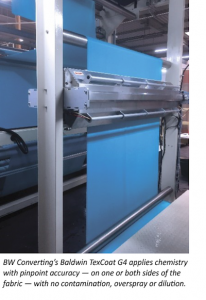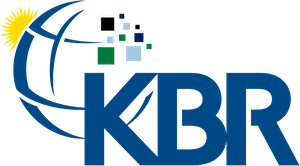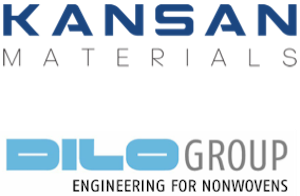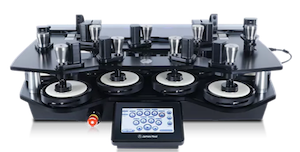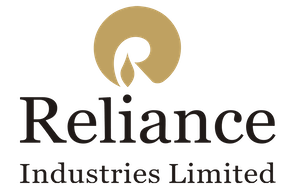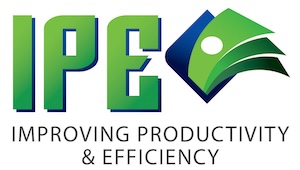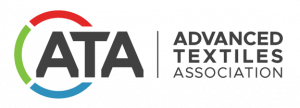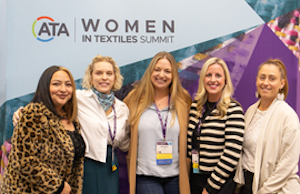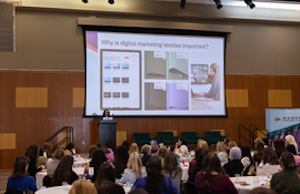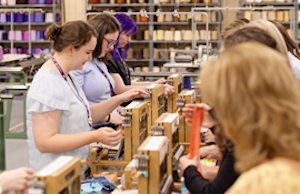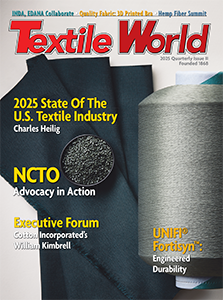 TEMPE, Ariz. — May 1, 2025 — Economic activity in the manufacturing sector contracted in April for the second month in a row, following a two-month expansion preceded by 26 straight months of contraction, say the nation’s supply executives in the latest Manufacturing ISM® Report On Business®.
TEMPE, Ariz. — May 1, 2025 — Economic activity in the manufacturing sector contracted in April for the second month in a row, following a two-month expansion preceded by 26 straight months of contraction, say the nation’s supply executives in the latest Manufacturing ISM® Report On Business®.
The report was issued today by Timothy R. Fiore, CPSM, C.P.M., Chair of the Institute for Supply Management® (ISM®) Manufacturing Business Survey Committee:
“The Manufacturing PMI® registered 48.7 percent in April, 0.3 percentage point lower compared to the 49 percent recorded in March. The overall economy continued in expansion for the 60th month after one month of contraction in April 2020. (A Manufacturing PMI® above 42.3 percent, over a period of time, generally indicates an expansion of the overall economy.) The New Orders Index contracted for the third month in a row following a three-month period of expansion; the figure of 47.2 percent is 2 percentage points higher than the 45.2 percent recorded in March. The April reading of the Production Index (44 percent) is 4.3 percentage points lower than March’s figure of 48.3 percent. The index returned to contraction last month after two months of expansion preceded by eight months of contraction. The Prices Index remained in expansion (or ‘increasing’) territory, registering 69.8 percent, up 0.4 percentage point compared to the reading of 69.4 percent in March. The Backlog of Orders Index registered 43.7 percent, down 0.8 percentage point compared to the 44.5 percent recorded in March. The Employment Index registered 46.5 percent, up 1.8 percentage points from March’s figure of 44.7 percent.
“The Supplier Deliveries Index indicated a continued slowing of deliveries, registering 55.2 percent, 1.7 percentage points higher than the 53.5 percent recorded in March. (Supplier Deliveries is the only ISM® Report On Business® index that is inversed; a reading of above 50 percent indicates slower deliveries, which is typical as the economy improves and customer demand increases.) The Inventories Index registered 50.8 percent, down 2.6 percentage points compared to March’s reading of 53.4 percent. The index indicated expansion for a second consecutive month after six months of contraction.
“The New Export Orders Index reading of 43.1 percent is 6.5 percentage points lower than the reading of 49.6 percent registered in March. The Imports Index dropped into contraction in April, registering 47.1 percent, 3 percentage points lower than March’s reading of 50.1 percent.”
Fiore continues, “In April, U.S. manufacturing activity slipped marginally further into contraction after expanding only marginally in February. Demand and output weakened while input strengthened further, conditions that are not considered positive for economic growth. Indications that demand weakened include the (1) New Orders Index continuing in contraction territory, (2) New Export Orders Index dropping sharply further into contraction, (3) Backlog of Orders Index contracting at a faster rate and (4) Customers’ Inventories Index remaining in ‘too low’ territory. Output (measured by the Production and Employment indexes) also weakened. Factory output (production) contracted further in April, indicating that panelists’ companies are continuing to revise production plans downward in the face of economic headwinds. The Employment Index ticked up but remained in contraction, as panelists’ companies continued to release workers. Companies generally opted for layoffs because they are quicker to implement than attrition. Inputs are defined as supplier deliveries, inventories, prices and imports. Except for Imports, the other indexes indicated expansion. Inventory growth is not a positive sign when demand is moving in the opposite direction; the recent expansion is considered a temporary move to avoid tariffs, and levels will decline when such trade issues are resolved. Supplier delivery performance reflects this pull-forward activity and delays in clearing goods through ports of entry.
“Demand and production retreated and destaffing continued, as panelists’ companies responded to an unknown economic environment. Prices growth accelerated slightly due to tariffs, causing new order placement backlogs, supplier delivery slowdowns and manufacturing inventory growth. Forty-one percent of manufacturing gross domestic product (GDP) contracted in April, down from 46 percent in March. The share of manufacturing sector GDP registering a composite PMI® calculation at or below 45 percent (a good barometer of overall manufacturing weakness) was 18 percent in April, an 11-percentage point increase compared to the 7 percent reported in March. Of the six largest manufacturing industries, four (Petroleum & Coal Products; Computer & Electronic Products; Machinery; and Chemical Products) expanded in April, one more as compared to March,” says Fiore.
The 11 manufacturing industries reporting growth in April — listed in order — are: Apparel, Leather & Allied Products; Petroleum & Coal Products; Plastics & Rubber Products; Electrical Equipment, Appliances & Components; Textile Mills; Computer & Electronic Products; Nonmetallic Mineral Products; Miscellaneous Manufacturing; Machinery; Chemical Products; and Primary Metals. The six industries reporting contraction in April, in order, are: Wood Products; Furniture & Related Products; Paper Products; Food, Beverage & Tobacco Products; Transportation Equipment; and Fabricated Metal Products.
WHAT RESPONDENTS ARE SAYING
- “Uncertainty over tariffs is providing a big challenge from both Tier-1 suppliers we will have to pay tariffs on directly and Tier-2 suppliers that will try to pass tariffs through to us in the form of price increases and tariff surcharges.” [Chemical Products]
- “Tariffs impacting operations — specifically, delayed border crossings and duties calculations that are complex and not completely understood. As a result, we are potentially overpaying duties. Unsure of potential drawbacks. Implementation of tariffs and their application is sudden and abrupt. The business is taking countermeasures.” [Transportation Equipment]
- “Business climate is apprehensive, and with tariff costs implemented, all inbound Chinese shipments are on hold. It is not feasible for our business or customers to sustain the pricing required to provide an acceptable margin.” [Computer & Electronic Products]
- “The most important topic is tariffs. Risks include margin erosion due to rising operational costs and freight delays disrupting delivery timelines. Supplier relationships are strained by pain-share negotiations, and competitors are gaining share by importing from lower-tariff regions.” [Food, Beverage & Tobacco Products]
- “Tariff whiplash is causing us major issues with customers. The two issues we are seeing: (1) customers are holding back orders to understand what is happening with tariffs on their products or (2) they are forcing us to accept the tariffs, which causes us to ‘no quote’ the job as we cannot take on that type of risk for an order.” [Machinery]
- “There is a lot of concern about the inflationary impacts from tariffs in our industry. Domestic producers are charging more for everything because they can.” [Fabricated Metal Products]
- “Tariff trade wars are incredibly volatile, quickly changing, and disrupting a ton of our current work. We are 90 percent sourced out of China, and the cost models keep changing every week. We are flying to visit suppliers in a few weeks to negotiate current terms and pricing, as well as develop more long-term, strategic plans to reduce risk in the region.” [Apparel, Leather & Allied Products]
- “Demand is slightly lower than plan, but it has been steady amid tariff concerns. Significant time has been spent quantifying the impact of changing tariff rates. Our costs will increase, and we are discussing how to share that impact across suppliers and customers.” [Electrical Equipment, Appliances & Components]
- “The recently imposed 145-percent tariff rate on Chinese imports is significantly affecting our 2025 profitability. Due to the complexity of our parts and the lack of alternate sources, we are unable to find any alternate suppliers — especially at a reasonable cost — to our current Chinese sources. Incoming orders have slowed due to market volatility and uncertainty.” [Miscellaneous Manufacturing]
- “Strategic procurement and the supply chain are paralyzed in a world that changes daily due to tariffs.” [Nonmetallic Mineral Products]
| MANUFACTURING AT A GLANCE April 2025 |
||||||
| Index | Series Index Apr |
Series Index Mar |
Percentage
Point Change |
Direction | Rate of Change |
Trend* (Months) |
| Manufacturing PMI® | 48.7 | 49.0 | -0.3 | Contracting | Faster | 2 |
| New Orders | 47.2 | 45.2 | +2.0 | Contracting | Slower | 3 |
| Production | 44.0 | 48.3 | -4.3 | Contracting | Faster | 2 |
| Employment | 46.5 | 44.7 | +1.8 | Contracting | Slower | 3 |
| Supplier Deliveries | 55.2 | 53.5 | +1.7 | Slowing | Faster | 5 |
| Inventories | 50.8 | 53.4 | -2.6 | Growing | Slower | 2 |
| Customers’ Inventories | 46.2 | 46.8 | -0.6 | Too Low | Faster | 7 |
| Prices | 69.8 | 69.4 | +0.4 | Increasing | Faster | 7 |
| Backlog of Orders | 43.7 | 44.5 | -0.8 | Contracting | Faster | 31 |
| New Export Orders | 43.1 | 49.6 | -6.5 | Contracting | Faster | 2 |
| Imports | 47.1 | 50.1 | -3.0 | Contracting | From Growing | 1 |
| OVERALL ECONOMY | Growing | Slower | 60 | |||
| Manufacturing Sector | Contracting | Faster | 2 | |||
Manufacturing ISM® Report On Business® data is seasonally adjusted for the New Orders, Production, Employment and Inventories indexes.
*Number of months moving in current direction.
COMMODITIES REPORTED UP/DOWN IN PRICE AND IN SHORT SUPPLY
Commodities Up in Price
Aluminum (17); Aluminum Products (2); Brass (2); Construction Materials; Cooking Oils; Copper (3);Corrugated Boxes (2); Critical Minerals (2); Electrical Components (3); Electronic Components (3); Maintenance, Repair, and Operations (MRO) Supplies; Packaging (2); Personal Protective Equipment (PPE); Plastic Resin (3); Power Train Products; Road Freight; Steel (3); Steel — Hot Rolled (3); Steel — Stainless (2); and Steel Products (2).
Commodities Down in Price
Gasoline and Diesel Fuel; and Natural Gas (2).
Commodities in Short Supply
Electronic Components (2); Plastic Resin; and Semiconductors.
Note: The number of consecutive months the commodity is listed is indicated after each item.
APRIL 2025 MANUFACTURING INDEX SUMMARIES
Manufacturing PMI®
The U.S. manufacturing sector contracted in April for the second consecutive month after two months of expansion preceded by 26 months of contraction. The Manufacturing PMI® registered 48.7 percent, 0.3 percentage point lower compared to the 49 percent reported in March. “After reversing its recent momentum in March, the Manufacturing PMI® again registered below its reading in December. Of the five subindexes that directly factor into the Manufacturing PMI®, two (Supplier Deliveries and Inventories) were in expansion territory, the same as last month. Slower supplier deliveries and slightly expanded inventories in April are not considered positives for the economy: Both conditions figure to be temporary and are driven by tariff concerns, either delaying buyer/seller negotiations or advancing material deliveries that will be reversed after tariffs are deployed, leading to a drawdown of manufacturing inventory. Although the Employment and New Orders indexes recovered somewhat, they remained in contraction. Of the six biggest manufacturing industries, four (Petroleum & Coal Products; Computer & Electronic Products; Machinery; and Chemical Products) registered growth,” says Fiore. A reading above 50 percent indicates that the manufacturing sector is generally expanding; below 50 percent indicates that it is generally contracting.
A Manufacturing PMI® above 42.3 percent, over a period of time, generally indicates an expansion of the overall economy. Therefore, the April Manufacturing PMI® indicates the overall economy grew for the 60th straight month after last contracting in April 2020. “The past relationship between the Manufacturing PMI® and the overall economy indicates that the April reading (48.7 percent) corresponds to a change of plus-1.8 percent in real gross domestic product (GDP) on an annualized basis,” says Fiore.
THE LAST 12 MONTHS
| Month | Manufacturing PMI® |
Month | Manufacturing PMI® |
| Apr 2025 | 48.7 | Oct 2024 | 46.9 |
| Mar 2025 | 49.0 | Sep 2024 | 47.5 |
| Feb 2025 | 50.3 | Aug 2024 | 47.5 |
| Jan 2025 | 50.9 | Jul 2024 | 47.0 |
| Dec 2024 | 49.2 | Jun 2024 | 48.3 |
| Nov 2024 | 48.4 | May 2024 | 48.5 |
| Average for 12 months – 48.5
High – 50.9 Low – 46.9 |
|||
New Orders
ISM®‘s New Orders Index contracted in April for the third consecutive month after three consecutive months of expansion, registering 47.2 percent, an increase of 2 percentage points compared to March’s figure of 45.2 percent. This reading is below the 12-month moving average (48.5 percent) for the New Orders Index, which hasn’t indicated consistent growth since a 24-month streak of expansion ended in May 2022. “Of the six largest manufacturing sectors, four (Petroleum & Coal Products; Machinery; Computer & Electronic Products; and Chemical Products) reported increased new orders. Two (Transportation Equipment; and Food, Beverage & Tobacco Products) reported declines. The percentages reporting ‘higher’ and ‘lower’ new orders both increased in April, an unusual sign and indication of a rare transition. Panelists noted a weakening level of demand performance, with a 1-to-1 ratio of positive comments versus those expressing concern about near-term demand. Overall, new orders continue to slow, as discussions about who will pay for potential tariff costs are the prime topic of negotiations between buyers and sellers. New orders are also struggling due to a lack of new orders from overseas customers,” says Fiore. A New Orders Index above 52.1 percent, over time, is generally consistent with an increase in the Census Bureau’s series on manufacturing orders (in constant 2000 dollars).
The eight manufacturing industries that reported growth in new orders in April, in order, are: Apparel, Leather & Allied Products; Petroleum & Coal Products; Plastics & Rubber Products; Machinery; Primary Metals; Computer & Electronic Products; Fabricated Metal Products; and Chemical Products. The six industries reporting a decline in new orders in April, in order, are: Wood Products; Paper Products; Furniture & Related Products; Transportation Equipment; Nonmetallic Mineral Products; and Food, Beverage & Tobacco Products.
| New Orders | %Higher | %Same | %Lower | Net | Index |
| Apr 2025 | 28.1 | 45.2 | 26.7 | +1.4 | 47.2 |
| Mar 2025 | 19.9 | 56.8 | 23.3 | -3.4 | 45.2 |
| Feb 2025 | 20.3 | 62.4 | 17.3 | +3.0 | 48.6 |
| Jan 2025 | 26.3 | 53.7 | 20.0 | +6.3 | 55.1 |
Production
The Production Index dropped further into contraction territory in April, registering 44 percent, 4.3 percentage points lower than the March reading of 48.3 percent. Prior to the readings of expansion in January and February, the index was in contraction territory for eight consecutive months, with the previous reading above 50 percent in April 2024 (50.7 percent). Of the six largest manufacturing sectors, two (Computer & Electronic Products; and Machinery) reported increased production. “Production levels in April showed a significant decrease for the second time in 2025, as order books remain weak and new orders continue to decline. Petroleum & Coal Products; Food, Beverage & Tobacco Products; and Transportation Equipment led the decline in output, causing head-count reductions at factories. Lack of capital investment due to business-climate uncertainty is also having a significant impact on production plans and output,” says Fiore. An index above 52.1 percent, over time, is generally consistent with an increase in the Federal Reserve Board’s Industrial Production figures.
The seven industries reporting growth in production during the month of April — in the following order — are: Textile Mills; Plastics & Rubber Products; Fabricated Metal Products; Computer & Electronic Products; Miscellaneous Manufacturing; Machinery; and Primary Metals. The eight industries reporting a decrease in production in April, in order, are: Furniture & Related Products; Wood Products; Petroleum & Coal Products; Paper Products; Food, Beverage & Tobacco Products; Transportation Equipment; Electrical Equipment, Appliances & Components; and Chemical Products.
| Production | %Higher | %Same | %Lower | Net | Index |
| Apr 2025 | 19.8 | 56.0 | 24.2 | -4.4 | 44.0 |
| Mar 2025 | 21.0 | 58.1 | 20.9 | +0.1 | 48.3 |
| Feb 2025 | 16.5 | 68.9 | 14.6 | +1.9 | 50.7 |
| Jan 2025 | 19.4 | 62.1 | 18.5 | +0.9 | 52.5 |
Employment
ISM®‘s Employment Index registered 46.5 percent in April, 1.8 percentage points higher than March’s reading of 44.7 percent. “The index posted its third consecutive month of contraction after expanding in January, with seven straight months of contraction before that. Since May 2022, the Employment Index has contracted in 29 of 36 months. Of the six big manufacturing sectors, three (Petroleum & Coal Products; Transportation Equipment; and Computer & Electronic Products) reported expanded employment in April. Respondents’ companies continue to reduce head counts through layoffs, attrition and hiring freezes; an approximate 1-to-1 ratio of hiring versus staff-reduction comments reflects an acceleration of head-count reductions due to the uncertain near- to mid-term demand. Layoffs were the primary tools used, an indication that head-count reduction is becoming more urgent,” says Fiore. An Employment Index above 50.3 percent, over time, is generally consistent with an increase in the Bureau of Labor Statistics (BLS) data on manufacturing employment.
Of the 18 manufacturing industries, the five industries reporting employment growth in April are: Apparel, Leather & Allied Products; Petroleum & Coal Products; Nonmetallic Mineral Products; Transportation Equipment; and Computer & Electronic Products. The eight industries reporting a decrease in employment in April, in the following order, are: Furniture & Related Products; Food, Beverage & Tobacco Products; Fabricated Metal Products; Plastics & Rubber Products; Primary Metals; Miscellaneous Manufacturing; Chemical Products; and Machinery.
| Employment | %Higher | %Same | %Lower | Net | Index |
| Apr 2025 | 13.1 | 70.7 | 16.2 | -3.1 | 46.5 |
| Mar 2025 | 8.3 | 73.7 | 18.0 | -9.7 | 44.7 |
| Feb 2025 | 12.0 | 70.9 | 17.1 | -5.1 | 47.6 |
| Jan 2025 | 11.7 | 75.1 | 13.2 | -1.5 | 50.3 |
Supplier Deliveries†
Delivery performance of suppliers to manufacturing organizations was slower for a fifth straight month in April, with the Supplier Deliveries Index registering 55.2 percent, a 1.7-percentage point increase compared to the reading of 53.5 percent reported in March. This continued expansion follows a contraction (which indicates faster delivery performance) in November, preceded by four consecutive months of slower deliveries, with four straight months of faster deliveries before that. After a reading of 52.4 percent in September 2022, the index went into contraction territory the following month and remained there for 20 out of 21 months, with February 2024 the exception. Of the six big industries, four (Petroleum & Coal Products; Transportation Equipment; Computer & Electronic Products; and Chemical Products) reported slower supplier deliveries in April. “Deliveries continued to be marginally strained as (1) suppliers struggled to meet accelerated delivery requests from panelists’ companies, (2) materials are delayed in processing at ports of entry and (3) suppliers and panelists’ companies negotiate who pays for applied tariffs,” says Fiore. A reading below 50 percent indicates faster deliveries, while a reading above 50 percent indicates slower deliveries.
The 10 manufacturing industries reporting slower supplier deliveries in April — in the following order — are: Textile Mills; Nonmetallic Mineral Products; Petroleum & Coal Products; Transportation Equipment; Furniture & Related Products; Paper Products; Computer & Electronic Products; Chemical Products; Miscellaneous Manufacturing; and Fabricated Metal Products. The only industry reporting faster supplier deliveries in April is Machinery. Seven industries reported no change in supplier delivery behavior in April as compared to March.
| Supplier Deliveries | %Slower | %Same | %Faster | Net | Index |
| Apr 2025 | 16.6 | 77.2 | 6.2 | +10.4 | 55.2 |
| Mar 2025 | 13.4 | 80.2 | 6.4 | +7.0 | 53.5 |
| Feb 2025 | 14.9 | 79.1 | 6.0 | +8.9 | 54.5 |
| Jan 2025 | 7.8 | 86.2 | 6.0 | +1.8 | 50.9 |
Inventories
The Inventories Index registered 50.8 percent in April, down 2.6 percentage points compared to the reading of 53.4 percent reported in March. Although the Inventories Index ‘gave back’ 2.6 percentage points of the 7.5 percentage points it gained in February and March, the last two readings have been the index’s highest since December 2022 (51.4 percent). Prior to March, the last time the Inventories Index was above 50 percent was in August (50.2 percent). Of the six big industries, two (Petroleum & Coal Products; and Chemical Products) grew input inventories in April. “Manufacturing inventories expanded in April, as panelists’ companies continue to pull forward (advance) deliveries of materials in an attempt to minimize the financial impacts of potential tariffs,” says Fiore. An Inventories Index greater than 44.5 percent, over time, is generally consistent with expansion in the Bureau of Economic Analysis (BEA) figures on overall manufacturing inventories (in chained 2000 dollars).
Of 18 manufacturing industries, the five industries reporting higher inventories in April are: Petroleum & Coal Products; Electrical Equipment, Appliances & Components; Plastics & Rubber Products; Chemical Products; and Primary Metals. The eight industries reporting lower inventories in April — listed in order — are: Paper Products; Textile Mills; Wood Products; Furniture & Related Products; Fabricated Metal Products; Transportation Equipment; Machinery; and Computer & Electronic Products.
| Inventories | %Higher | %Same | %Lower | Net | Index |
| Apr 2025 | 20.8 | 59.2 | 20.0 | +0.8 | 50.8 |
| Mar 2025 | 21.5 | 65.7 | 12.8 | +8.7 | 53.4 |
| Feb 2025 | 14.6 | 72.4 | 13.0 | +1.6 | 49.9 |
| Jan 2025 | 12.2 | 67.4 | 20.4 | -8.2 | 45.9 |
Customers’ Inventories†
ISM®‘s Customers’ Inventories Index registered a reading of 46.2 percent in April, a decrease of 0.6 percentage point compared to the reading of 46.8 percent in March. “Customers’ inventory levels in April continued to contract and moved slightly further from ‘about right’ territory. (For more information about the Customers’ Inventories Index, see the ‘Data and Method of Presentation’ section below.) Panelists are reporting that the amounts of their companies’ products in their customers’ inventories suggest a demand level that remains positive for future production,” says Fiore.
The two industries reporting customers’ inventories as too high in April are: Plastics & Rubber Products; and Computer & Electronic Products. The 10 industries reporting customers’ inventories as too low in April, in order, are: Furniture & Related Products; Wood Products; Primary Metals; Transportation Equipment; Electrical Equipment, Appliances & Components; Food, Beverage & Tobacco Products; Fabricated Metal Products; Machinery; Miscellaneous Manufacturing; and Chemical Products. Six industries reported no change in customers’ inventories in April as compared to March.
| Customers’ Inventories |
% Reporting |
%Too High |
%About Right |
%Too Low |
Net |
Index |
| Apr 2025 | 76 | 11.1 | 70.2 | 18.7 | -7.6 | 46.2 |
| Mar 2025 | 77 | 11.8 | 70.0 | 18.2 | -6.4 | 46.8 |
| Feb 2025 | 77 | 8.0 | 74.6 | 17.4 | -9.4 | 45.3 |
| Jan 2025 | 77 | 9.0 | 75.4 | 15.6 | -6.6 | 46.7 |
Prices†
The ISM® Prices Index registered 69.8 percent in April, increasing 0.4 percentage point compared to the March reading of 69.4 percent, indicating raw materials prices increased for the seventh straight month after a decrease in September. The Prices Index has increased 15 percentage points over the past six months to record its highest reading since June 2022 (78.5 percent). Of the six largest manufacturing industries, five — Machinery; Chemical Products; Food, Beverage & Tobacco Products; Computer & Electronic Products; and Transportation Equipment — reported price increases in April. “The Prices Index indicated increasing prices in April for the seventh consecutive month, driven by increases in steel and aluminum prices impacting the entire value chain, as well as the general 10-percent tariff applied to many imported goods. Forty-nine percent of companies reported higher prices in April, compared to 46 percent in March. This share has consistently increased over the past six months, from a low of 12.2 percent in November,” says Fiore. A Prices Index above 52.8 percent, over time, is generally consistent with an increase in the Bureau of Labor Statistics (BLS) Producer Price Index for Intermediate Materials.
In April, the 15 industries that reported paying increased prices for raw materials, in order, are: Textile Mills; Furniture & Related Products; Nonmetallic Mineral Products; Machinery; Miscellaneous Manufacturing; Fabricated Metal Products; Chemical Products; Food, Beverage & Tobacco Products; Primary Metals; Paper Products; Computer & Electronic Products; Electrical Equipment, Appliances & Components; Transportation Equipment; Wood Products; and Plastics & Rubber Products. No industries reported paying decreased prices for raw materials in April.
|
Prices |
%Higher | %Same | %Lower | Net | Index |
| Apr 2025 | 49.2 | 41.1 | 9.7 | +39.5 | 69.8 |
| Mar 2025 | 46.0 | 46.7 | 7.3 | +38.7 | 69.4 |
| Feb 2025 | 31.4 | 61.9 | 6.7 | +24.7 | 62.4 |
| Jan 2025 | 20.7 | 68.3 | 11.0 | +9.7 | 54.9 |
Backlog of Orders†
ISM®‘s Backlog of Orders Index registered 43.7 percent, a decrease of 0.8 percentage point compared to the March reading of 44.5 percent, indicating order backlogs contracted for the 31st consecutive month after a 27-month period of expansion. Of the six largest manufacturing industries, only one (Computer & Electronic Products) reported expansion in order backlogs in April. “Given the state of weak new orders and now reduced production output in key industries, the hoped-for return of expanding backlogs continues to be delayed until trade issues and other geopolitical tensions recede,” says Fiore.
Of the 18 manufacturing industries, five reported growth in order backlogs in April: Nonmetallic Mineral Products; Electrical Equipment, Appliances & Components; Primary Metals; Miscellaneous Manufacturing; and Computer & Electronic Products. The 11 industries reporting lower backlogs in April — in the following order — are: Apparel, Leather & Allied Products; Paper Products; Wood Products; Petroleum & Coal Products; Plastics & Rubber Products; Furniture & Related Products; Food, Beverage & Tobacco Products; Chemical Products; Transportation Equipment; Fabricated Metal Products; and Machinery.
| Backlog of Orders |
% Reporting |
%Higher |
%Same |
%Lower |
Net |
Index |
| Apr 2025 | 92 | 15.1 | 57.2 | 27.7 | -12.6 | 43.7 |
| Mar 2025 | 91 | 15.4 | 58.2 | 26.4 | -11.0 | 44.5 |
| Feb 2025 | 92 | 14.0 | 65.5 | 20.5 | -6.5 | 46.8 |
| Jan 2025 | 93 | 12.6 | 64.6 | 22.8 | -10.2 | 44.9 |
New Export Orders†
ISM®‘s New Export Orders Index contracted for the second month in a row in April after expanding for two consecutive months, registering 43.1 percent in April, down from March’s reading of 49.6 percent. This 6.5 percentage point decrease is the largest since April 2020, when the index dropped 11.3 percentage points. “The rate of decrease for the New Export Orders Index is the fastest since the coronavirus pandemic, and excluding COVID-19, the reading is the lowest since the Great Recession (42.9 percent in April 2009). Export orders contracted for the second consecutive month after growing in January and February. This brief period of expansion followed an ‘unchanged’ status (a reading of 50 percent), preceded by six straight months of contraction. New export orders contracted sharply due to the combination of slow overseas growth as well as the application of counter tariffs applied to a multitude of U.S. manufactured products,” says Fiore.
Of the 18 manufacturing industries, none reported growth in new export orders in April. The 12 industries reporting a decrease in new export orders in April — in the following order — are: Electrical Equipment, Appliances & Components; Textile Mills; Paper Products; Furniture & Related Products; Transportation Equipment; Fabricated Metal Products; Primary Metals; Machinery; Chemical Products; Food, Beverage & Tobacco Products; Computer & Electronic Products; and Miscellaneous Manufacturing. Six industries reported no change in new export orders in April as compared to March.
| New Export Orders |
% Reporting |
%Higher |
%Same |
%Lower |
Net |
Index |
| Apr 2025 | 74 | 8.7 | 68.8 | 22.5 | -13.8 | 43.1 |
| Mar 2025 | 73 | 12.1 | 74.9 | 13.0 | -0.9 | 49.6 |
| Feb 2025 | 73 | 12.9 | 77.0 | 10.1 | +2.8 | 51.4 |
| Jan 2025 | 74 | 12.0 | 80.8 | 7.2 | +4.8 | 52.4 |
Imports†
ISM®‘s Imports Index contracted in April after expanding for three straight months. The April reading of 47.1 percent is 3 percentage points lower than the reading of 50.1 percent reported in March. Before expanding in January, the index contracted for seven months in a row, preceded by five consecutive months of expansion, with 14 straight months of contraction prior to that. “Imports contracted as demand has reduced the need to maintain the same level of imports compared to prior months,” says Fiore.
The six industries reporting an increase in import volumes in April, in order, are: Apparel, Leather & Allied Products; Wood Products; Textile Mills; Primary Metals; Plastics & Rubber Products; and Miscellaneous Manufacturing. The seven industries that reported lower volumes of imports in April — in the following order — are: Petroleum & Coal Products; Furniture & Related Products; Machinery; Fabricated Metal Products; Chemical Products; Transportation Equipment; and Electrical Equipment, Appliances & Components.
| Imports | % Reporting |
%Higher |
%Same |
%Lower |
Net |
Index |
| Apr 2025 | 82 | 15.4 | 63.4 | 21.2 | -5.8 | 47.1 |
| Mar 2025 | 86 | 16.5 | 67.1 | 16.4 | +0.1 | 50.1 |
| Feb 2025 | 85 | 16.4 | 72.3 | 11.3 | +5.1 | 52.6 |
| Jan 2025 | 85 | 11.6 | 78.9 | 9.5 | +2.1 | 51.1 |
†The Supplier Deliveries, Customers’ Inventories, Prices, Backlog of Orders, New Export Orders, and Imports indexes do not meet the accepted criteria for seasonal adjustments.
Buying Policy
The average commitment lead time for Capital Expenditures in April was 169 days, an increase of four days compared to March. The average lead time in April for Production Materials was 84 days, an increase of four days compared to March. The average lead time for Maintenance, Repair and Operating (MRO) Supplies was 46 days, a decrease of one day compared to March.
| Percent Reporting | ||||||||
| Capital Expenditures |
Hand-to- Mouth |
30 Days | 60 Days | 90 Days | 6 Months | 1 Year+ | Average Days |
|
| Apr 2025 | 16 | 4 | 11 | 14 | 28 | 27 | 169 | |
| Mar 2025 | 17 | 3 | 10 | 15 | 30 | 25 | 165 | |
| Feb 2025 | 17 | 4 | 9 | 14 | 30 | 26 | 168 | |
| Jan 2025 | 17 | 4 | 8 | 15 | 30 | 26 | 168 | |
| Percent Reporting | ||||||||
| Production Materials |
Hand-to- Mouth |
30 Days | 60 Days | 90 Days | 6 Months | 1 Year+ | Average Days |
|
| Apr 2025 | 10 | 24 | 25 | 26 | 9 | 6 | 84 | |
| Mar 2025 | 8 | 24 | 27 | 28 | 9 | 4 | 80 | |
| Feb 2025 | 8 | 22 | 28 | 28 | 8 | 6 | 85 | |
| Jan 2025 | 6 | 25 | 29 | 26 | 9 | 5 | 83 | |
| Percent Reporting | |||||||
| MRO Supplies | Hand-to- Mouth |
30 Days | 60 Days | 90 Days | 6 Months | 1 Year+ | Average Days |
| Apr 2025 | 31 | 33 | 18 | 12 | 5 | 1 | 46 |
| Mar 2025 | 30 | 33 | 20 | 10 | 6 | 1 | 47 |
| Feb 2025 | 29 | 37 | 16 | 13 | 4 | 1 | 45 |
| Jan 2025 | 29 | 34 | 19 | 11 | 6 | 1 | 47 |
Posted: May 2, 2025
Source: Institute for Supply Management



